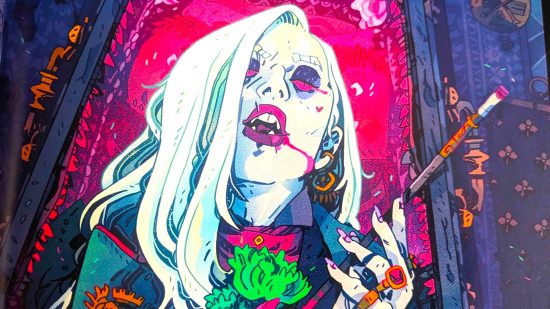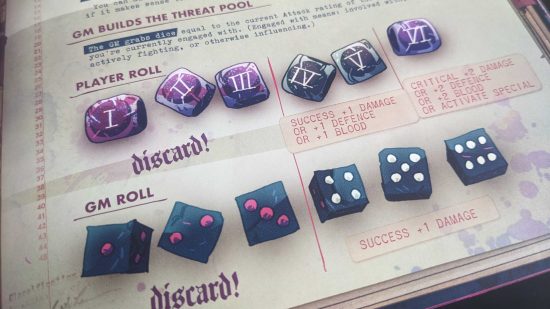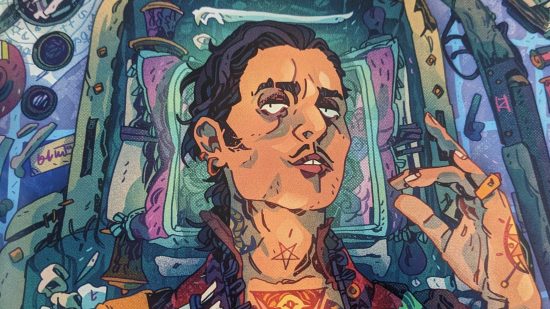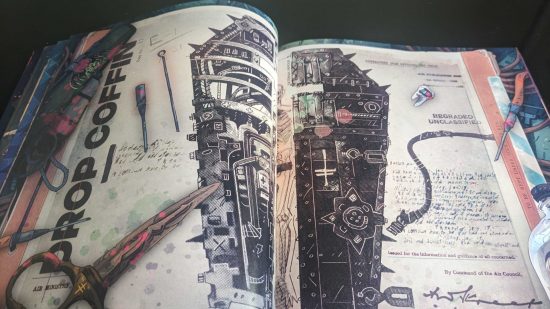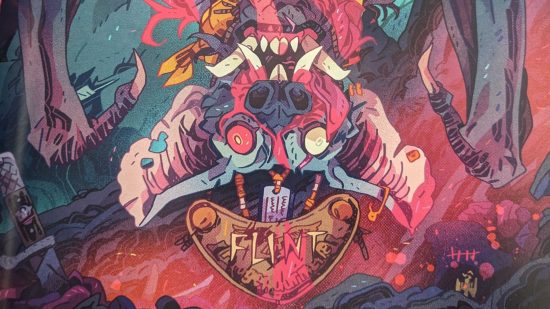Our Verdict
Eat the Reich has a narrow scope and an even narrower target audience. Players must be as comfortable with collaborative storytelling as they are with gory descriptions of vampire-on-Nazi violence. The combat system has one or two hiccups, but otherwise, this is a stylish tabletop RPG that, for the right kind of player, absolutely sticks the landing.
- Stunning visual design
- Encourages fast-paced, creative roleplay
- Design has huge amounts of character
- A mostly successful political statement
- An imperfect combat system
- Violent Nazi-killing roleplay is a hard sell for many
- Limited opportunities for deep storytelling
Eat the Reich takes up the mantle carried by many horror movies and videogames in the past, offering players a brutal brawl set in a supernatural version of the Second World War. But how good can a tabletop RPG about drinking Nazi blood really be? Both mechanically, and ethically?
Before we get to the Nazi-punching Eat the Reich review, a bit of housekeeping. Firstly, this review isn’t based on a copy provided by the publisher. I bought Eat the Reich with my hard-earned Wargamer wages. Secondly, my thoughts are based on multiple thorough read-throughs, as well as a one-shot playthrough with some willing allies.
With that settled, let’s kick this pig.
What is Eat the Reich?
“The year is 1943. You are a unit of crack vampire commandos coffin-dropped into occupied Paris. You have one mission: drink all of Hitler’s Blood.”
Eat the Reich is light on rules and simple in concept – that blurb text succinctly summarizes its whole schtick. System-wise, it’s a slim and stylish tabletop RPG, designed for extended one shots and mini campaigns. And each session has only two goals: kill Nazis, and drink blood.
A swarm of pre-generated vamp characters are provided, each with flavorful features that, if the right conditions are met, add extra d6s to your skill check dice pool. The gun-toting guerrilla fighter Nicole can summon a swarm of rats to fight on her behalf, while the Nosferatu-like Flint can turn his body to goo and – we quote – “glop around”.
When you roll a fistful of dice, you assign successes to a number of tasks. Thin the number of foes shooting at you, drink blood to fuel special features, defend against attacks, or simply progress the story.
Whatever you do, your party of crack commandos will be ripping and tearing their way through a sandbox-style map of occupied Paris. Survive enough boss battles with the supernatural forces of the Third Reich, and you’ve got a shot at Hitler himself – and winning the war.
Rules-wise, that’s Eat the Reich in a shotgun shell. But this hyper-vibrant, glow-in-the-dark bit of text is more than just a game. It’s also a political statement.
Your first clue that this is the case is on page three, where designer Howitt explains the ethical stance behind Nazi punching. “This game is not, in and of itself, an act of resistance”, Howitt writes. “It is an act of creativity which reflects our frustration with the real world’s ongoing Nazi problem.”
Eat the Reich fully supports violence against Nazis, both historical and modern, real and roleplayed. Despite how cartoonishly evil these figures are in modern media, this statement may be surprisingly contentious.
Further demonstrating the design team’s political leanings, Eat the Reich then introduces some of the most thorough safety tools I’ve seen in tabletop gaming.
Lines and veils are explained, and Eat the Reich even has a complete ‘evil calibration checklist’ to help establish just how dark your players are comfortable with things getting in-game.
The GM is given excellent advice on how to roleplay some of history’s most heinous figures (namely, don’t – they don’t deserve to have voices or rich narratives). Plus, Eat the Reich addresses its approach to discrimination, the Holocaust, and how vampirism interacts with the context of real-world religions. This game may laugh at the suffering of Nazis, but it takes that act very seriously.
Who is Eat the Reich for?
It’s easiest to begin by explaining who Eat the Reich isn’t for. Obviously, anyone who feels uncomfortable roleplaying as or interacting with Nazis should stay away. The rulebook itself has a sensitive and left-leaning mission statement, but the punk politics get a little lost during play, when the blood and guts start to fly like Silly String.
Similarly, this book isn’t for the squeamish. Eat the Reich generally draws the line at topics like sexual assault and violence against children, but pretty much everything else is on the table.
You’re encouraged to dream up over-the-top acts of mutilation, without the constraints of boring old biology. One of my players wanted to disguise himself as a bowl of punch and explode a party of Nazis from within, and I was going to damn well let him.
You can sneak and charm your way through scenarios in Eat the Reich, but all roads eventually lead to a bloodbath. This means, compared to other RPGs, there aren’t as many opportunities for social intrigue and deep character roleplay. Eat the Reich is fast-paced and punchy, leaving little time for lamenting your immortal condition or chit-chatting with German soldiers.
Still here? In that case, you might be just the person Eat the Reich was designed for. Players who like describing horrific violence with a hint of schlock will vibe with the vision. Similarly, players who like unusual systems with a narrow but novel concept will find a lot to love. And guess what? It’s me, I’m ‘players’.
Is Eat the Reich good or bad?
The first Medal of Honor goes to Eat the Reich’s visual design. Will Kirkby’s hyper-colorful illustrations strike the right balance of grimy and glossy, and the graphic design is thematic without making the book too difficult to read. Embossed text and a literal glow-in-the-dark cover make this one of the prettiest RPGs I’ve bought since Mörk Borg.
Locations, boss fights, and player-characters all have a distinct identity, and they’re stuffed with personality. Eat the Reich takes you from a crumbling amusement park where a rust witch causes planes to plummet from the sky, to a blazing gunfight against a mech-man in the German Technology Pavilion. You’ll brawl all the way to the Eiffel Tower, where Hitler is hiding in an outlandishly opulent zeppelin.
Gameplay is open and highly collaborative. As long as the narrative is kept vaguely consistent, players are encouraged to introduce any details they like to a scene. Need a balcony to take strategic aim from? Describe it, and it’s there. Want to loot the somehow-still-living brain of a Nazi and mine it for intel? Sure, go nuts.
Despite the difference in genre, this is about as close as it gets to a Doom tabletop RPG. The stakes are comically high, the mechanics are simple, and joyful violence is the name of the game.
Brutality goes both ways, though. Every time a player makes a roll, a GM gets their own dice pool, representing the Nazi threats that are pushing back. Any successes that aren’t defended against turn into an injury – and it only takes six to kill a character. Assigning the right number of successes to an objective is the only way to move the story forward, but you’ll need to dedicate just as much time to drinking blood and healing up.
It’s in the center of this action I find my only real issue with Eat the Reich. As already mentioned, you have a range of actions you can perform with successful dice rolls. However, not all of these are made equal.
Objectives are top priority, as knocking points off allows you to move one step closer to the Führer. Next comes drinking blood, as this lets you activate special powers and clear injuries. Defending means you can remove successful attacks from the GM’s dice pool, and activating extra-special abilities is downright enjoyable.
That leaves one last action – reducing Threats. Individual or groups of enemies are represented by a Threat number, which can be reduced by assigning successful dice. Reduce a Threat to zero, and it can’t attack you. But if a Threat ever reaches zero, it gets partially restored at the end of the round.
This encourages you to keep pushing forward rather than get bogged down bashing every Nazi you see. But it also makes the Threat reduction action feel redundant. Why waste dice when you can tough it out and beat the Objective faster? Eat the Reich suggests making Objective values higher if your players game the system too much, but this feels like a poorly-applied Bandaid.
Eat the Reich certainly isn’t for everyone, and it is an extremely limited RPG experience. But overall, it nails the goal it set out to achieve.
Even after several hours of exuberant executions, its powerful politics managed to shine through. When my players finally got their claws on Adolf Hitler, they implanted false memories in his brain that showed him what life would be like if he’d been accepted into art school. In this universe, his last moments showed him what a monster he had truly become.
And then he was impaled on top of the Eiffel Tower. Gutting, gory, glorious.
